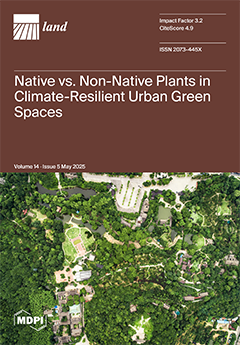Reconstructing relationships between urban agglomeration and relevant ecosystems from an ecosystem services perspective and quantitatively assessing their interactive status holds significant implications for achieving coordinated development. Taking Shandong Peninsula Urban Agglomeration (SPUA) as our study area, we developed a Cities-ESV Coupling Index (
[...] Read more.
Reconstructing relationships between urban agglomeration and relevant ecosystems from an ecosystem services perspective and quantitatively assessing their interactive status holds significant implications for achieving coordinated development. Taking Shandong Peninsula Urban Agglomeration (SPUA) as our study area, we developed a Cities-ESV Coupling Index (
I) serving as a composite metric for assessing city–ecosystem coupling dynamics through a multidimensional framework encompassing the following: (1) urban development level, (2) ecosystem service value (ESV), (3) ecosystem service physical quantity, and (4) spatial balance degree of ecosystem service, operationalized through 10 selected indicators. Our methodology integrates ESV quantification, biophysical assessment, correlation analysis modeling, and spatial autocorrelation modeling to comprehensively evaluate coupling relationships between cities and ecosystems across 16 cities and 78 counties. This study innovatively integrates ESV quantification with biophysical assessment methodologies in indicator selection, while strategically incorporating spatial agglomeration metrics. The multidimensional framework effectively addresses the prevalent oversimplification in existing ecosystem service measurement paradigms. The findings are as follows: the total ESV is 13,977.87 × 10
8 CNY/a, which accounts for about 20% of the total GDP of SPUA. The Cities-ESV coupling index (
I) of four cities, including Dongying, Linyi, Yantai, and Weifang, ranks among the top in SPUA, while that of seven counties, namely Weshan, Qixia, Yiyuan, Yishui, Mengyin, and Linqu, is at a relatively high-level. The conclusion is as follows: the total ESV in SPUA had been continuously decreasing. The coupling relationship between cities and ecosystems are significantly negatively correlated, and the Cities-ESV coupling index (
I) of SPUA has obvious regional differentiation characteristics. Therefore, differentiated ecological land protection policies should be formulated to curb the trend of continuous decline in ESV.
Full article





